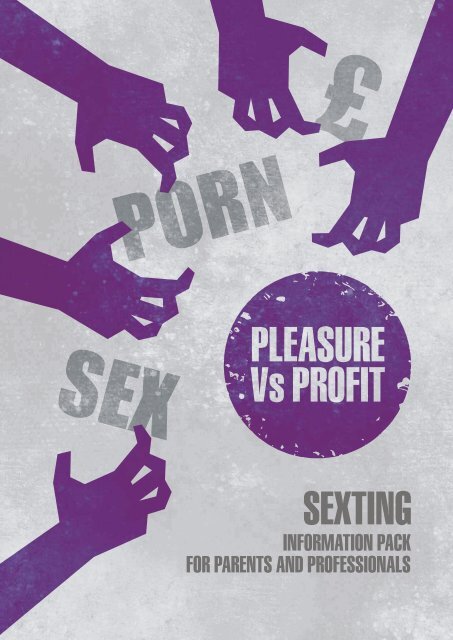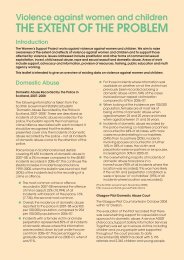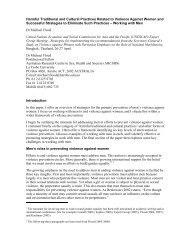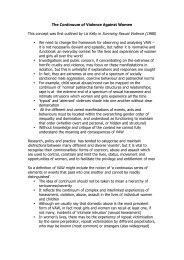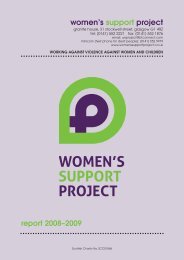SEXTING
Sexting - Women's Support Project
Sexting - Women's Support Project
- No tags were found...
Create successful ePaper yourself
Turn your PDF publications into a flip-book with our unique Google optimized e-Paper software.
<strong>SEXTING</strong><br />
INFORMATION PACK<br />
FOR PARENTS AND PROFESSIONALS
<strong>SEXTING</strong><br />
WHAT IS <strong>SEXTING</strong>?<br />
Sexting is sending sexually explicit messages via mobile phone, email, web chat,<br />
social networking sites, Bluetooth or instant messenger. To put it simply Sexting =<br />
sex + texting.<br />
Sexually explicit would include naked images, pictures of genitals, masturbation,<br />
and ejaculation. Images most commonly being shared include BYM exposing or<br />
flashing their genitals as well as masturbating or ejaculating. GYW share images of<br />
themselves undressing or naked, exposing or flashing their genitals as well as<br />
masturbating. All of these types of acts could be considered pornographic.<br />
What is concerning about the activity is its rapidly increasing popularity and it not<br />
merely an extension of 'I'll show you mine if you show me yours' behaviour. Explicit<br />
images are also often taken when the victim was not in a position to make a good<br />
decision, such as at a party where large amounts of alcohol have been consumed or<br />
when consent was not given to the sex being filmed and shared.<br />
WHY IS IT HAPPENING?<br />
Technology has advanced and mobile phones now have the capability to record and<br />
send photos and video. With the ease of this, sending suggestive and explicit<br />
messages and pictures has increased, especially among teens. (Pew Research<br />
Center's Internet & American Life Project 2009 –<br />
http://pewresearch.org/pubs/1093/generations-online ) The availability of the<br />
means to do this has been accompanied by the pressure and expectations that CYP<br />
should adopt adult behaviours and they are using these images as part of selfpromotion<br />
and branding online.<br />
There are also expectations on YM to have images of girlfriends and partners and<br />
they are asking for these to be provided. This entitlement needs to be challenged<br />
and YM need to know that it is not acceptable to use these images in any way to<br />
blackmail, humiliate or embarrass. In addition possession and distribution of the<br />
images may constitute an offence even if the YW has ‘willingly’ provided them.<br />
1
HOW IS IT HAPPENING?<br />
It is becoming increasing common for young people to take and share sexually<br />
explicit images. It is difficult to give exact numbers but different surveys suggest<br />
around one third of young people are doing this. 70% of 11-18 year olds surveyed<br />
were found to have known the sender of the sexually explicit message personally.<br />
23% of messages were found to have come from a current partner, 45% from<br />
friends and 2% from adults. (MTV / AP Study ‘Thin Line’ –<br />
http://www.athinline.org/about#research)<br />
WHAT ARE THE IMPACTS?<br />
CYP are often unaware of the actual and potential consequences of their actions.<br />
Once in cyberspace these images can never be erased and can be transmitted<br />
around the world in a very short space of time. Again possession and distribution<br />
may constitute an offence, depending on the nature of the images.<br />
WHAT CAN BE DONE?<br />
Parents must be prepared to discuss this issue with their children prior to<br />
secondary school as these behaviours are regularly seen at S1 and S2 level. It is<br />
imperative that protective adults embrace technology for the valuable tool that it is<br />
and engage with children in cyberspace as well as in the real world. CYP need the<br />
opportunity to gain knowledge and skills to safely navigate cyberspace, to identify<br />
risks and take appropriate steps to keep themselves safe.<br />
. Key messages to get across to young people:<br />
Don't assume anything you send or post is going to remain private.<br />
There is no changing your mind in cyberspace – anything you send or post will<br />
never truly go away.<br />
Don't give in to the pressure to do something that makes you uncomfortable,<br />
even in cyberspace.<br />
Consider the recipient's reaction.<br />
Nothing is truly anonymous.<br />
2
WARN YOUR CHILDREN ABOUT THE CONSEQUENCES OF <strong>SEXTING</strong>.<br />
It is important to remind your children of the dangers of sexting, including the legal<br />
implications and the dangers of sexual predators.<br />
REMIND CHILDREN TO THINK BEFORE THEY ACT.<br />
Often children do not consider the full implications of sexting. Make sure to fully<br />
educate them so they know exactly what the dangers are. Hopefully they will then<br />
be less likely to do something they will later regret.<br />
TELL CHILDREN THAT SENDING OR POSSESSING CHILD<br />
PORNOGRAPHY IS ILLEGAL.<br />
Tell your child that it is illegal to possess or distribute naked photos of anyone who<br />
is under-age, and that the penalties for breaking these laws are severe.<br />
WARN THEM ABOUT SEXUAL PREDATORS.<br />
Remind your children how easy it is for photos to fall in to the wrong hands, and<br />
warn them that once a photo is online they will be unable to track it and it might<br />
be there forever.<br />
WARN THEM NEVER TO ASK ANOTHER PERSON FOR AN IMAGE.<br />
You need to talk with your CYP about the potential consequences for them and<br />
others of taking, sending or distributing sexual images. They should not put any<br />
pressure, emotional blackmail or threats on another person to send images and<br />
they should not be any part of a chain where this is happening. They need to be<br />
aware that this is illegal if anyone involved is under the age of 18.<br />
TALK ABOUT WHY PEOPLE HUMILIATE, BLACKMAIL OR BULLY<br />
OTHERS THROUGH IMAGES.<br />
It seems that the potential of new technology has added another way in which<br />
young people can achieve status with their peers. The sharing of images has been<br />
linked to young people, usually young men, vying for power within their peer group<br />
and using others, usually young women's images as the means to do that. We need<br />
to talk with our CYP as to why it is unacceptable to be part of any humiliation,<br />
bullying or blackmailing.<br />
3
PARENTS SHOULD LEARN HOW TO USE AND MONITOR THEIR<br />
CHILDREN'S MOBILE PHONES.<br />
Familiarise yourself with your child's mobile phone and keep an eye on its usage<br />
and content, and get to know what it is and is not capable of doing.<br />
PARENTS SHOULD CHECK PHOTO GALLERIES ON THEIR CHILDREN'S<br />
FACEBOOK AND MYSPACE ACCOUNTS.<br />
Shoulder-surf when your children are online, and take a look around their social<br />
networking pages. Take the plunge and make your own account, get to know the<br />
sites, and make sure to keep up with your children's activities when online. Make<br />
sure to keep an eye on their page to ensure they don't willingly or otherwise post<br />
up information or photos that they may regret.<br />
GIVE YOUR CHILDREN CLEAR RULES ON WHAT THEY CAN AND<br />
CAN'T DO WITH THEIR MOBILE PHONE.<br />
Establish a firm set of rules of what your child can and cannot do with their mobile<br />
phones including consequences if they break the rules.<br />
This was abbreviated from a full fact sheet at: www.community.nsw.gov.au.<br />
4
Z E R O T O L E R A N C E<br />
WOMEN’S<br />
SUPPORT<br />
PROJECT<br />
scottish<br />
community<br />
foundation<br />
www.womenssupportproject.co.uk


